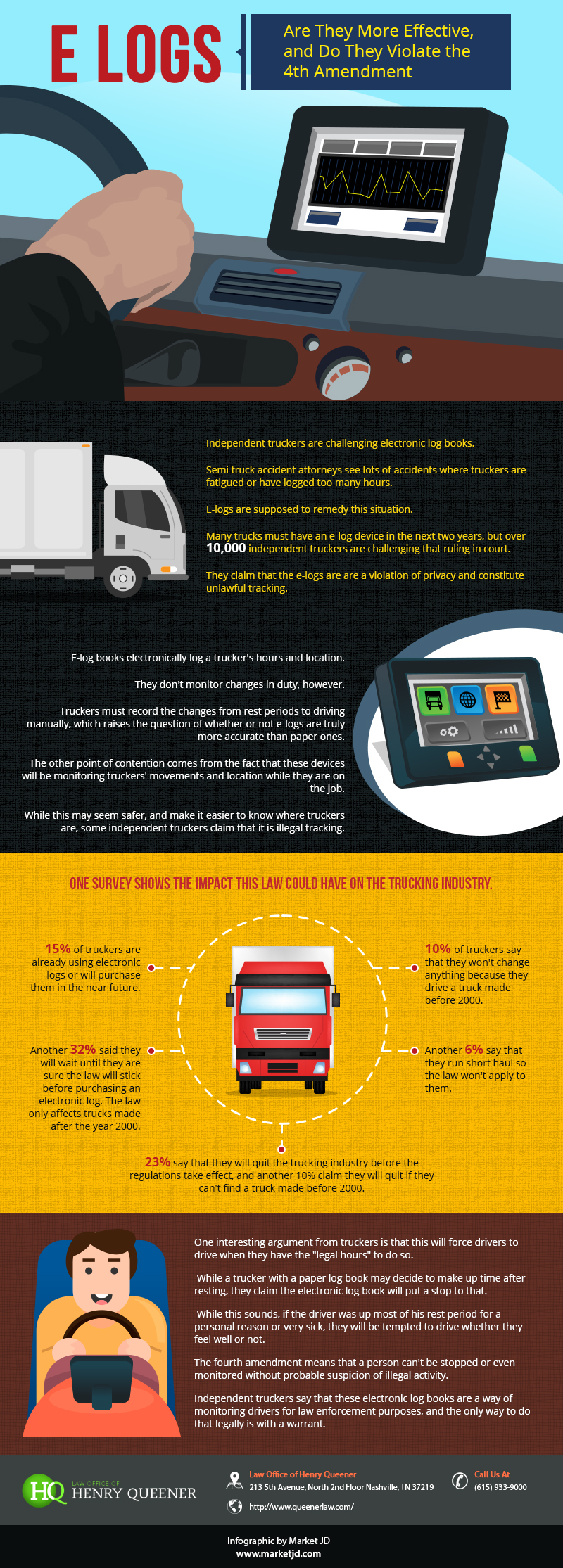
by Queener Law | Apr 10, 2016 | Colorado, Kentucky, Tennessee, Trucking Accident
Semi truck accident attorneys see lots of accidents where truckers are fatigued or have logged too many hours. E-logs are supposed to remedy this situation. Many trucks must have an e-log device in the next two years, but over 10,000 independent truckers are challenging that ruling in court. They claim that the e-logs are are a violation of privacy and constitute unlawful tracking.
E-log books electronically log a trucker’s hours and location. They don’t monitor changes in duty, however. Truckers must record the changes from rest periods to driving manually, which raises the question of whether or not e-logs are truly more accurate than paper ones.
The other point of contention comes from the fact that these devices will be monitoringtruckers‘ movements and location while they are on the job. While this may seem safer, and make it easier to know where truckers are, some independent truckers claim that it is illegal tracking.
One survey shows the impact this law could have on the trucking industry. 15% of truckers are already using electronic logs or will purchase them in the near future. Another 32% said they will wait until they are sure the law will stick before purchasing an electronic log. The law only affects trucks made after the year 2000. 10% of truckers say that they won’t change anything because they drive a truck made before 2000. Another 6% say that they run short haul so the law won’t apply to them. 23% say that they will quit the trucking industry before the regulations take effect, and another 10% claim they will quit if they can’t find a truck made before 2000.
One interesting argument from truckers is that this will force drivers to drive when they have the “legal hours” to do so. While a trucker with a paper log book may decide to make up time after resting, they claim the electronic log book will put a stop to that. While this sounds more safe, if the driver was up most of his rest period for a personal reason or very sick, they will be tempted to drive whether they feel well or not.
The fourth amendment means that a person can’t be stopped or even monitored without probable suspicion of illegal activity. Independent truckers say that these electronic log books are a way of monitoring drivers for law enforcement purposes, and the only way to do that legally is with a warrant.Categories
Archives

by Queener Law | Apr 3, 2016 | Tennessee, Trucking Accident
Federal trucking regulations aim to reduce traffic accidents, but they fail to address many of the root causes of the problem. Poor visibility and the corresponding inability to react to changing road conditions, play a major role in the frequency and severity of traffic accidents.
A Nashville truck accident lawyer can point to seven factors that limit visibility, primarily through driver negligence.
Time Of Day
Nighttime driving has always been more dangerous than driving during the day. Not only does darkness induce fatigue, it has a strong impact on visibility.
A National Highway Traffic Safety Administration (NHTSA) study in 2007 reported to Congress that nighttime visibility is severely limited because of night glare and range issues. Night glare from oncoming traffic destroyed the night vision of drivers, especially those over 50, leading to temporary blindness and potential loss of vehicle control. The NHTSA found night glare the most problematic in areas with few streetlights or other roadside sources of light.
Sun
Driving during particular periods of daylight is no less dangerous than driving at night, depending on the direction the truck is traveling. Truckers driving into the sunlight at sunrise or sunset face protracted periods of intense sunlight and glare from the roofs and glass of other vehicles.
Many trucking companies require drivers to use sunglasses or other protective eyewear in the hour before sunrise or sunset as a way to reduce the impact of the sun on driver visibility.
Fatigue
The NHTSA blames a large portion of trucking accidents on driver fatigue, and for good reason. Drivers face longer work weeks than ever before, and trucking companies have put increased pressure on drivers to stay on the road at all costs.
Fatigue hinders visibility in two ways. First, drivers fight to stay awake, and closed eyes provide no visibility and a complete inability to prevent an accident. Second, even when a driver is awake, fatigue causes blurriness and sluggish reaction times. As a result, drivers are unable to judge distances in time to stop before a collision.
Speeding
The difference between a deadly accident or a fender bender is often a matter of inches. Speeding trucks have lower reaction times than other vehicles, and any errors the driver makes are magnified in a crash.
If the truck was speeding, a Nashville truck accident lawyer may be able to prove the driver was liable for an accident, because the truck driver left himself without enough time to stop. Scientific evidence and the truck’s own computer can provide the hard evidence a Nashville truck accident lawyer needs to argue the case.
Eyesight
Truckers, especially long haul drivers, spend days or weeks on the road at one time. While they are on the road, it’s easy to let health and medical issues slide, if those issues do not directly hinder the driver’s ability to keep the truck on the road.
A driver with a weak prescription has an increasingly short field of vision, and the problem can only be solved with a trip to an optometrist and a new set of glasses. Not every driver is willing or able to take the time to stop for new glasses, wrongly assuming that the problem can wait until they get home. The slow degeneration of the field of vision can lead to drivers with an effective eyesight of 20/50 or worse.
Other Drivers
Not every problem with visibility is the trucker’s fault. Sometimes the actions of other drivers play a role in the accident. Even with proper mirror positioning, a trucker still has large blind spots around the vehicle. The most dangerous spots are near the driver’s door, from the trailer hitch to the nose of the truck on the passenger side, and the nose of the truck.
Drivers who slam on their brakes or drive for long distances in a truck’s blind spot greatly increase the probability of an accident. Through an examination of the positions of other vehicles involved in an accident, a Nashville truck accident lawyer may be able to prove that the accident was not the fault of the trucker, but another driver.
Weather
Hard rain and snow diminish a driver’s field of vision in a matter of seconds. When this occurs, truckers must adjust their driving patterns to slow down and avoid accidents.
A Nashville truck accident lawyer can expand a liability suit after an accident to include the trucking company if there were maintenance issues involved in the accident. A trucking company that fails to replace worn out wiper blades or provide other safety equipment puts everyone on the road at risk.
Truck accidents are serious, and are more likely to be deadly than other vehicle collisions. With the assistance of a truck accident lawyer, victims can apply liability where it belongs and seek compensation.
(Article continues

by Queener Law | Mar 19, 2016 | Tennessee, Trucking Accident
Truck accidents were on a steady decline several years ago. Unfortunately, this positive trend has sharply reversed, as laws have became more lenient. Of course, their sheer size makes driving around big rigs dangerous, but when truck drivers experience fatigue, the results can be deadly.
Staggering Statistics
In 2009, truck-related deaths were at an all-time low, and 2,983 truck accidents were responsible for 3,380 deaths. In 2013, the last year that these finalized statistics were available, over 3,500 wrecks resulted in nearly 4,000 deaths. In Tennessee alone, there were 126 truck-related accidents in 2013. Trucking accidents are responsible for one in every seven highway deaths in this country.
According to the U.S. Department of Transportation, driver fatigue is the leading cause of trucking accidents. Of course, there are plenty of additional factors that contribute to large vehicle crashes, but it’s wise for everyone on the road to keep an eye out for drowsy drivers.
Safety Laws
Over the past few years, there have been some modifications to trucking safety laws, but they may be short-lived. In 2013, Federal law reduced the maximum hours a trucker can work each week to 70, from 82. Drivers who hit their limit must take a 34 hour rest period before starting a new work week. This rest-session must include two periods between 1 and 5 am. Drivers may not drive for more than 11 hours each day, which must include a 30 minute break.
As helpful as these laws may be to reducing trucking accident deaths, many trucking industry officials are citing a decline in profits as their reasoning behind their push for a repeal of these regulations. They have also pushed for changes to the 80,000 pound haul limit, along with length regulations that mandate that no truck can haul a trailer over 28 feet. If they get their way, a double-trailer rig could carry trailers that are 33 feet long, making the truck as long as an eight-story building is tall.
Some groups, like the Federal Motor Carrier Safety Administration, are pushing for additional safety measures. Since 2008, they have recommended that drivers get screened for sleep apnea, a condition that is closely linked to sleep deprivation. Unfortunately, due to the high cost of testing, they have recently backed off.
As updates to the laws continue to be debated, safety advocates and truck accident attorneys urge that drivers use caution on the roads.

by Queener Law | Mar 17, 2016 | Tennessee, Trucking Accident
Washington, DC – April 25, 2016—This week the United States Senate began deliberations on a new budget for the Department of Transportation. Though the purpose of the bill is to fund both the Department of Transportation and HUD, there are provisions in the budget that are deeply troubling to groups lobbying for safer roads.
Groups opposing the bill point to several key provisions that indicate capitulation to the trucking industry, and increase the risk of accidents. The most controversial provision changes the current calculation on hours of service restarts for drivers.
Current rules state that drivers are required to take a 34 hour break once they reach their hours of service cap for a seven day period. The break reduces driver fatigue, the leading cause of semi truck accidents. The new bill would permanently roll back hours of service restarts to pre-2011 levels, a decision which significantly reduces the downtime between restarts and eliminates mandatory 30 minute breaks for long-haul drivers.
The trucking industry and its lobbyists argue the reduction in restart periods is vital to maintain profitability for trucking companies and higher wages for drivers. Profits for trucking companies have remained flat since the start of the Great Recession, despite the recent drop in the price of diesel. If trucking companies are unable to increase the turnover rate of their trucks through more frequent deliveries, American Trucking Associations believe there will be a collapse of the transportation industry.
Henry Queener, a semi truck accident lawyer in Nashville, sees proposed changes to the hours of service in the Department of Transportation budget as a clear step in the wrong direction. “We’ve seen a steady increase in the number of fatal semi truck accidents, as well as continued increases in the economic cost of accidents. Putting tired drivers on the road, and encouraging drivers to miss hour of service restarts, will make all of our roads a lot less safe”.
The budget debate is certain to be contentious, especially after the trucking industry suffered setbacks with proposed speed limiters and a Congressional refusal to increase the size and weight of trucks.

by Queener Law | Mar 16, 2016 | Tennessee, Trucking Accident
New rules make it easier to hold truckers accountable for how many hours they are behind the wheel. This will cut down on the number off accidents caused by sleepy drives, officials hope.
A new proposal would require truckers to electronically record their time behind the wheel. This has been mandated by federal law late in 2015, but Tennessee has not yet officially adopted the measure. When there is an accident with a big truck, there are often fatalities. Studies have shown one reason trucks get into accidents is tired or sleepy drivers, an this rule is aimed at making that happen less often.
In 2013 rules were passed by the Tennessee Legislature that limit how much time a trucker can drive, and it required certain amounts of time to be taken off. Recording the hours electronically takes it a step further by making verification easier.
A Nashville truck accident lawyer said he welcomed the changes.
“Ultimately we want to see fewer accidents and fewer deaths on the highways,” Henry Queener of the Queener Law Office in Nashville said. “Holding truckers accountable will help keep them off the road when they are drowsy. It might also protect them from being abused by their companies, so it benefits everyone.”
According to an Associated Press story, truckers have kept paper logs in the past, but new technology will keep track of engine hours, vehicle movement, miles driven, and location, which will make it hard for anyone to work around the system. For years paper records have been kept, but it was easy to keep two sets of records, or to even just put in wrong information.
Truckers often face a double edged sword of sorts. The temptation is great at times to grab another load. They may not feel tired, think they can handle it and the money is tempting. Also sometimes employers give hard deadlines and drivers are behind the wheel longer than they should be. Either situation can make them sleepy and unsafe behind the wheel. If you are in an accident contact a truck accident lawyer in Tennessee.

by Queener Law | Mar 14, 2016 | Colorado, Kentucky, Tennessee, Trucking Accident
Despite the attention that distracted driving and large truck accidents has had in the media over the last few years, and federal laws which are geared towards reducing the number of accidents due to distracted driving, recent investigations reveal that distracted driving still remains a problem for truck drivers. In fact, distracted driving plays a role in an estimated 8 percent of large truck accidents each year. While 8 percent doesn’t seem like a number of much magnitude, when an individual considers that there are approximately 4,000 fatalities due to large truck accidents in the United States each year, and an estimated 284 injuries each day caused by accidents with big rigs, 8 percent is actually a large number.
Since safety advocates first began evaluating the issue of distracted driving and the big rigs, the use of cellphones has been a major focus. In 2012, a federal law went into effect banning the use of handheld cellphones while operating a commercial truck. The law includes interstate truck drivers and bus drivers as well as drivers who transport “placardable quantities of hazardous materials”.
The Dangers of Using Cellphones While Driving
Countless commercial vehicle drivers still use their cellphones regularly while driving, but the effects of doing so can be catastrophic.
- Research shows that commercial motor vehicle operators who use their cellphones to text while driving are 23 times more likely to become involved in an accident or safety critical event than drivers who did not text and drive.
- Truck drivers who use their cellphones to place or receive calls and performed other operations that required dialing were 6 times more likely to experience an event than those who avoided such cellphone usage.
- Drivers who reach for a cellphone or other object in such a manner that interferes with a safe driving position are approximately 7 times more likely to become involved in a safety critical event.
Drivers typically take their eyes off of the road for between 3.8 and 4.6 seconds when texting or dialing. During that short period of time a commercial vehicle traveling approximately 55 mph. will cover more ground than a football field- an estimated 300 ft.
While using handheld devices is strictly prohibited, using them in a hands-free manner is generally acceptable. Any hands-free device needs to be within close proximity to the trucker. Additionally, the federal regulations regarding cellphones do not apply to devices used for dispatching unless texting is involved.
The Penalties for Driving and Using Cellphones
For those who are caught texting or using handheld cellphones while operating a motor vehicle, the penalties can be severe.
- Drivers can face fines of up to $2,750
- Second and subsequent offenses can result in the truck driver being placed out of service for up to 120 days.
- Violations will have a negative impact on the employer’s Safety Measurement System rating.
- Employers can be fined up to $11,000 if they require or knowingly allow their truck drivers to text or use hand-held cellphones while operating a commercial vehicle.
- Violations of the law are considered to be serious traffic violations and penalties are taken with consideration of the existing Federal Motor Carrier Safety Administration guidelines.
In addition to the above stated penalties, drivers who violate the law could be subject to whatever punishments their employer wishes to dish out in accordance to their own policies. Since many companies have policies that are similar to those regulations set forth by the federal law, and truckers who use handheld cellphones while driving are at a higher risk for accidents, they are like lawsuits waiting to happen. Termination of employment upon violation of the law is common.
Although many states have not set their own laws regarding commercial vehicles and cellphone usage, truckers should be aware that they are still required to follow the regulations set forth by the federal law when traveling interstate, regardless of the state they are in.
Other Forms of Distracted Driving Among Truck Drivers
Unfortunately, using cellphones while driving is not the only form of distracted driving that effects truckers and their risk of accidents. The unique lifestyle that goes along with trucking brings with it a strong temptation, and sometimes necessity, to perform other tasks while driving. Two of the more common distractions among truckers are:
- Eating or Drinking: Due to strict deadlines, many truckers don’t have the time to pull over and eat when they are hungry. Therefore, they often grab something to go and eat on the road to make deliveries on time.
- Reading Maps or GPS Screens: Since truckers often travel in areas that they are unfamiliar with, it is an extremely common practice for them to take their eyes off of the road to look at directions.






